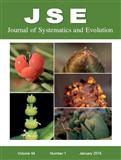Yuan Xu, Chi-Ming Hu, Gang Hao
A close relationship between Androsace and related genera (Douglasia, Vitaliana, and Pomatosace) has long been recognized. Recent molecular studies have provided abundant evidence that Douglasia, Vitaliana, and Pomatosace are nested within Androsace and together constitute the monophyletic “Androsace group”. We investigated the pollen morphology of 80 taxa representing all sections of Androsace s.s. as traditionally construed, as well as Douglasia, Vitaliana, and Pomatosace,to see whether they are congruent with phylogenetic relationships. We uncovered subtle variation in pollen morphology within the group. The shape of pollen grains ranges from spheroidal to perprolate. Pollen size ranges from 9.37 µm in Androsace sect. Samuelia to 20.68 µm in Douglasia. Exine ornamentation includes microreticulate, microechinate, perforate, and rugulate types. The polar view varies from circular, triangular and planaperturate, to triangular and angulaperturate. Various pollen morphological characters support the monophyly of major clades, including /Septentrionalis, /Pomatosace, /Orthocaulon, and /Megista, which were recognized previously based on molecular evidence.

